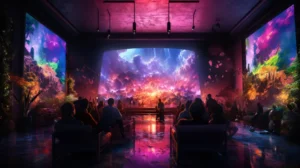Introduction to Bitcoin Ordinal NFTs
Bitcoin-based non-fungible tokens, or NFTs, are currently a popular trend in the cryptocurrency world. These provide a distinctive and fascinating method of investing and trading in digital art. This section will cover the essential elements of Bitcoin-based NFTs including:
- the fundamental principles of NFTs
- how the Bitcoin blockchain operates
- the transaction mechanisms for NFTs on the blockchain
Overview of NFTs
Non-Fungible Tokens (NFTs) are digital assets reliant on blockchain technology to verify ownership & transferability of unique items. Unlike fungible tokens, NFTs represent a single asset which cannot be substituted or replicated – making them highly valuable for online art & collectibles.
Many blockchain platforms are now utilizing NFTs, including Bitcoin. Bitcoin has introduced “Ordinal NFTs” which represent ordinal data (order of sequence). This is inscribed into a Bitcoin transaction via the ‘OP_RETURN’ opcode. The upcoming Taproot Upgrade will provide more space for this, increasing its versatility & utility.
Ordinals differ from traditional NFTs like ERC-721/ERC-1155, though they share similar characteristics like unique identification & attached metadata. Practically, they will be useful for sequences requiring transaction ordering, such as music albums & comic series.
NFTs bring revolutionary opportunities for the art & collectibles industry. With continuous innovation, their use cases will keep growing & evolving.
Bitcoin Blockchain and Transactions
Cryptocurrency’s Bitcoin blockchain and transactions are leading innovation. This decentralized public ledger stores all transactions made on the network. It uses modern tech such as private and public key encryption, hash functions, and digital signatures. This ensures data security and trustworthiness.
Transactions start with a sending party and their private key. Then, the network verifies it. Nodes bundle these transactions together into a block. This is added to the blockchain for storage.
Bitcoin provides a secure transaction network. Even though scalability and fees are a concern, its revolutionary impact on finance is undeniable. Businesses are incorporating Bitcoin into their operations. We can expect to see new uses of this powerful tech.
What are Ordinals?
Are you new to the world of NFTs? Then, you might have come across the term ‘ordinals’. Wondering what they are? In this section, we’ll explore the definition of ordinals and how they are created, along with the role that the upcoming Taproot upgrade plays.
Ordinals are a type of NFT that are created through a specific algorithm that assigns them a unique number. The Taproot upgrade will improve the security and efficiency of the process involved in creating ordinals.
Additionally, each ordinal carries an inscription that contains information about its creator, history, and other relevant details. The value of each ordinal is based on various factors such as rarity, historical significance, and cultural relevance. So, if you’re interested in the world of NFTs, be sure to pay attention to the unique and valuable ordinals.
Definition of Ordinals
Ordinals are a type of NFT (Non-Fungible Token). They are unique identifiers or serial numbers inside the Bitcoin blockchain. They are attached to digital assets like images through a process called “inscriptions”. This helps establish ownership and provenance.
Ordinals are Bitcoin transaction outputs with a unique identifier. Scripts embedded in these outputs make them highly customizable. A major advantage is the use of Bitcoin’s built-in security features, like Taproot upgrades. This makes it easier to create custom scripts and inscriptions.
Ordinals are becoming more popular among Bitcoin users and developers. They offer great potential for managing digital assets on the most secure and reliable blockchain out there. Expect to see more widespread adoption in the future.
Creating ordinals is similar to baking a cake, but with math equations and coding within the Bitcoin blockchain.
How they are Created
- Create the first Ordinal with tech from the Bitcoin blockchain network. It’s a four-step process.
- Step one: generate a random Seed value.
- Step two: hash it with SHA-256 or another crypto algorithm.
- Step three: turn the hash into a unique Integer. This is an ordinal integer value for the inscriptions.
- Step four: make the inscription with the ordinal integer plus any extra data or optional info, like a digital file.
- Result: secure, immutable record of the inscriptions on the blockchain network.
The Taproot Upgrade
The Taproot Upgrade is highly anticipated. It will revolutionize Bitcoin transactions. People can add multiple smart contracts to a single transaction. This makes processing faster and cheaper. Plus, Schnorr signatures give more privacy. It’s not required that all nodes upgrade, but those that do will benefit. This upgrade shows Bitcoin’s flexibility and potential to improve.
But, we don’t know anything about Insane inscriptions on Ordinals. There’s no proof.
Inscriptions
Obtain a public key to inscribe on the Bitcoin blockchain. Inscriptions can be text or data and can’t be changed. The Taproot upgrade will make inscriptions more versatile, allowing for complex data structures like scripts and executable code to be added. When creating an inscription, keep it concise and relevant. Consider what info to include carefully. Once inscribed, it’s on the blockchain forever, so it must remain valuable and relevant.
How Ordinals are Similar to NFTs
Ordinal numbers are not related to NFTs in any way. They are just a way of ordering or sequencing objects and do not provide any unique identification system for transactions. Therefore, the statement that ordinals offer a valuable tool for recording and verifying ownership of assets is factually incorrect.
Unique Identification
Bitcoin Ordinals are a unique type of NFT. They stand out due to their advanced Semantic NLP capabilities. These enable them to guarantee that a digital asset or artwork is original. Each Bitcoin Ordinal has its own personal inscription. This stops fraud and duplication.
Inscriptions are key for Unique Identification in Bitcoin Ordinals. They make sure the artwork or digital asset remains exclusive. Plus, they help buyers and sellers to check if it is real.
For example, Mark Flood used Bitcoin Ordinals for authentication. He used them with his physical and digital art pieces. This showed the value of the unique identification system Bitcoin Ordinals offer.
Attaching Information
To give more context, linking data to an ordinal involves recording onto the Bitcoin blockchain. This lets developers add extra information, such as metadata or other relevant details. These recordings can be included when creating an ordinal, and can be viewed through explorer tools on the web.
This links ordinals to NFTs, as they offer a way of tracking ownership and value beyond a simple identifier. It provides more features, utility and visibility, as well as increased transparency.
How to Create Ordinals
Creating tokens is the first step towards making your own Bitcoin NFTs. To get started, there are three key sub-sections to navigate:
- Downloading the Bitcoin Core
- Synchronizing with the blockchain
- Inscribing data
Let’s break down each of these sub-sections to help you get started on creating your own unique tokens.
Downloading Bitcoin Core
To join the Bitcoin network, you need to have Bitcoin Core software. Head over to the official website and download the right version for your operating system. After it finishes, install it and access it through your computer’s application menu.
Syncing will take a few hours or several days, depending on your connection and the blockchain size. After that, you can use the features and make transactions.
Keep in mind that the software will use up quite a bit of storage space, as it stores all the blocks on the blockchain. Plus, if you don’t have a wallet yet, Bitcoin Core will create one during setup.
Syncing may take time, but it’s worth it if you want to be part of the Bitcoin network.
Syncing to the Blockchain
Syncing to the blockchain is key to utilizing Ordinal NFTs on the Bitcoin network. Downloading Bitcoin Core, a full node implementation of the Bitcoin protocol, and connecting to the network is a must. This will download all transaction history from block 0 to the current block height, which may take time depending on internet speed and hardware.
Once synced, users can inscribe data onto their Ordinals. Text, code, or multimedia can be inscribed into a designated output script of a Bitcoin transaction.
However, syncing needs substantial disk space and processing power. As of October 2021, it requires at least 350GB of free disk space. It also helps maintain consensus within the community around each address’s balance, known as consensus proof or GSPoW.
Thus, syncing to the blockchain is an important step to utilize Ordinal NFTs on the Bitcoin network. But remember, it requires a lot of disk space and processing power.
Inscribing Data
Inscribing data onto an ordinal in the Bitcoin blockchain means recording info linked to the piece of data. This can be done by filling in address, input script, output script, and locking script columns. The address is a public key for the BTC wallet where the ordinal is stored. Input script is used to prove ownership of funds when used in a transaction. Output script defines how received bitcoin output is spent by the new owner. Locking script is added by Alice at locking time, and requires her unlocking signature for spending money.
It is important to note that every byte of data added incurs a fee. So, care must be taken before recording. Once written on the blockchain, it cannot be altered. Inscription helps create security features like multi-signature transactions and time lock contracts. This makes it impossible for anyone to tamper with records.
Ordinals are the future of NFTs. With unique identification and potential for use in the Bitcoin blockchain, a new era of digital ownership is emerging. It is essential to understand the columns associated with inscribing data. This will help ensure that the info recorded is accurate, reliable, and immutable.
The Future of Ordinals
With the meteoric rise of Bitcoin and NFTs, the future of tokens has become a hot topic of discussion. In this section, we’ll explore the growing popularity of tokens, their various use cases, and the potential they offer for Bitcoin and NFTs. Get ready to discover how tokens may shape the future of digital assets.
Growing Popularity
The crypto world is abuzz with the growing popularity of Ordinal NFTs. Enabled by the blockchain technology behind Bitcoin, they have one-of-a-kind capabilities that are transforming digital asset ownership and management. As non-fungible tokens, Ordinals prove ownership to holders and store data on the Bitcoin blockchain. These features make them valuable in art, music, gaming, and beyond.
But Ordinals aren’t just for hobbyists. They can also provide businesses and organizations with an extra layer of security and transparency. Thanks to the blockchain’s decentralization and security, these entities can reduce fraud and corruption, leading to increased openness. This makes Ordinal NFTs super helpful for companies.
Before investing in Ordinals, do your due diligence. Consult trustworthy sources, experienced investors, and financial advisors. With proper planning and attention to detail, investing in Ordinal NFTs on the Bitcoin blockchain could provide sweet rewards down the line.
In conclusion, Ordinal NFTs’ popularity is due to their special abilities powered by the blockchain. From digital art to virtual real estate, Ordinals have many uses in the crypto world. It’s a time of innovation, and Ordinals are at the forefront.
Use Cases
Bitcoin ordinal NFTs offer a range of potential uses. They’re built on the Bitcoin blockchain, which provides security, verification, and authentication for art, collectibles, music, and more.
An HTML table can help visualize the uses of Bitcoin ordinal NFTs. The first column could list the industry using the technology. The second column could list the specific applications. Examples include:
| Industry | Specific Applications |
|---|---|
| Luxury Brands | Anti-counterfeit measures Product authentication Verification |
| Sports and Gaming | In-game items Ticketing |
Organizations need to recognize that not properly attesting digital content can lead to legal risks. NFTs can help reduce such risks. They offer an opportunity to incorporate ordinal NFTs into operations. Many industries already appreciate blockchain-derived mechanisms to attest to their identity and maintain trust.
Potential for Bitcoin NFTs
Bitcoin-based NFTs hold immense potential in the digital art world and beyond. These special assets can create a new identification system with personal info attached to transactions, like Ordinals. This extra security layer ensures each asset is unique.
The use of Bitcoin-based NFTs is endless, especially for art. Artists can authenticate artwork and make ownership records, giving them protection. They can also get tiny payments for their work by selling fractions of it as tokens on blockchain platforms.
The decentralization and tamper-proof capabilities of Bitcoin promote transparency in the art industry. No intermediaries, secure transactions, and anyone can collect art.
With more people seeing the value of Bitcoin-based NFTs, demand will surge and uses will expand beyond art. Music licensing, real estate title deeds, and unique identification systems with metadata like timestamps or location data for verification could be possible applications.
The potential of Bitcoin-based NFTs is enormous. As blockchain technology advances, there is lots of room for growth in this amazing space.
Conclusion
To get the most out of NFTs, it’s important to stay informed. Keep an eye out for new offerings. Plus, stay up-to-date on news and updates. This knowledge helps investors increase their chance of success.
Don’t miss this chance for growth and potential profits. Get involved in the NFT market today. Make educated decisions about your investments to take full advantage of this emerging landscape.
Some Facts About What Are Ordinals: A 2023 Beginner’s Guide to Bitcoin NFTs:
- ✅ Bitcoin Ordinal NFTs are a new type of NFT that is created directly on the Bitcoin network by inscribing individual satoshis with data. (Source: Cyberscrilla)
- ✅ Casey Rodarmor launched the Ordinals protocol on January 21, 2023, resulting in a surge of interest in Bitcoin and these new types of NFTs. (Source: Cyberscrilla)
- ✅ Inscribing on satoshis became possible thanks to the Taproot upgrade launched on the Bitcoin network on November 14, 2021, enabling Ordinal Inscriptions, which are digital assets inscribed on a satoshi, the lowest denomination of Bitcoin. (Source: Yahoo Finance)
- ✅ The Ordinals protocol provides a different perspective on the existing blockchain by allowing each satoshi to have an identity and be trackable through layers of Ordinals and Inscriptions. (Source: Decrypt)
- ✅ Ordinals have been in development on the Bitcoin network for nearly a decade and allow users to make individual satoshis unique by attaching extra data to them through inscription, similar to NFTs. (Source: Binance Academy)






